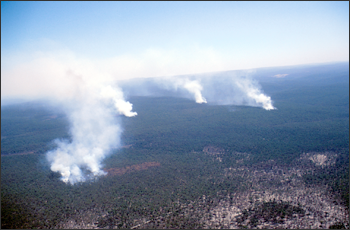Source: Commonwealth Scientific and Industrial Research Organisation
In the summer of 2002-03, bushfires burnt through 700,000 ha of forests in northeast Victoria in Australia. This region supplies 38 percent of the water that flows into the Murray-Darling River, the main source of water supply for much of Australia’s irrigated agriculture, the city of Adelaide and many towns along the river.

In a country where wildfires are prevalent and water supplies are at a premium, understanding the impact of wildfires on the water catchments is vital. A study by CSIRO Forest Biosciences has helped shed light on how impacts of fires might be more accurately estimated in future.
“Understanding the long-term impact of fires on water yield from major catchments is critical to understanding the long-term security of water supplies to cities, farms and the environment,” says Dr Richard Benyon of CSIRO Forest Biosciences.
“The study demonstrated a promising technique for catchment managers to more accurately predict changes in stream flow following wildfire, not only in northeast Victoria, but elsewhere in Australia.”
CSIRO remote sensing specialists analysed Landsat satellite images from before and after the 2003 fires to accurately map changes in the forest cover from which changes in water availability were predicted.
Initially, the loss of vegetation as a result of the fires meant the burnt areas used less water so there was more entering streams because it was not being used by the trees, however, this short-term effect does not last. As the forest grows back and the young trees consume more water, substantial reductions in water yield from the catchment can be expected over coming decades.
Victoria’s North East Catchment Management Authority Chief Executive John Riddiford says the research provides a real capacity to predict the impact of forest fire on water yield over large areas for the first time.
“With the potential impacts of climate change, including the lower rainfall and increased risk of wildfire, it is important for catchment authorities to understand these possible impacts and to plan accordingly,” he says.
Dr Benyon says long-term impacts of wildfires on water yield is dependent on the type and condition of the forest before fires, the intensity of fires and the subsequent type, density and vigour of forest recovery.
+ Read CSIRO press release (external link)
+ See related CSIRO images (external link)

Be Part of What’s Next: Emerging Applications of Landsat at AGU24
Anyone making innovative use of Landsat data to meet societal needs today and during coming decades is encouraged to submit and abstract for the upcoming “Emerging Science Applications of Landsat” session at AGU24.





